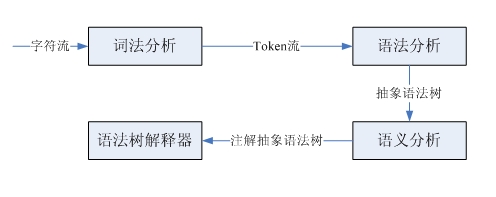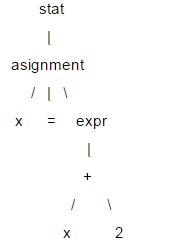Python を使用して基本的なコード インタプリタを作成する際の重要なポイントの分析
私はコンパイラーとパーサーに常に非常に興味を持っていますが、コンパイラーの概念と全体的なフレームワークについてはよく理解していますが、詳細についてはあまり知りません。私たちが書くプログラムのソースコードは、実際には文字列です。コンパイラやインタプリタは、この文字列を直接理解して実行できます。この記事では、Python を使用して、(Python のリストに似た) 小さなリスト操作言語を解釈するための単純なパーサーを実装します。実際、コンパイラとインタプリタは、基本理論を理解していれば、それほど神秘的なものではありません (もちろん、製品レベルのコンパイラやインタプリタは依然として非常に複雑です)。
このリスト言語でサポートされている操作:
対応する出力:
コンパイラとインタプリタが入力文字ストリームを処理するとき、それらは基本的に人間が文章を理解する方法と一致します。例:
英語の学習が初めての場合は、まず各単語の意味を知り、次に各単語の品詞を分析して主語-述語-目的語の構造に一致させ、その意味を理解する必要があります。文。この文は文字列であり、字句分割により字句単位ストリームが得られ、これによって文字ストリームから字句単位ストリームへの変換が完了する。品詞を分析し、主語・動詞・目的語の構造を特定するのが英語の文法に基づくものであり、入力された語彙単位の流れに基づいて文法解析木が特定されます。最後に、単語の意味と文法構造を組み合わせて、最終的に文の意味を取得します。コンパイラーとインタープリターの処理プロセスは似ていますが、ここではインタープリターのみに焦点を当てます。

字句解析と構文解析は、それぞれ字句パーサーと構文パーサーによって実行されます。これら 2 つのパーサーは同様の構造と機能を持ち、どちらも入力シーケンスを入力として受け取り、特定の構造を識別します。字句パーサーはソース コードの文字ストリームからトークン (字句単位) を 1 つずつ解析し、構文パーサーは部分構造と字句単位を識別して何らかの処理を実行します。どちらのパーサーも、LL(1) 再帰降下パーサーによって実装できます。このタイプのパーサーによって実行されるステップは、句の型を予測し、部分構造を照合する解析関数を呼び出し、字句単位を照合してから、コードを挿入することです。必要なカスタムアクションを実行します。
ここでは LL(1) について簡単に説明します。ステートメントの構造は通常、解析ツリーと呼ばれるツリー構造で表されます。LL(1) は構文解析に解析ツリーを使用します。例: x = x +2;
 このツリーでは、x、=、2 などの葉ノードを終端ノードと呼び、それ以外を非終端ノードと呼びます。 LL(1) を解析する場合、特定のツリー データ構造を作成する必要はありません。このようにして、非終端ノードごとに解析関数を作成し、対応するノードが見つかったときにそれを呼び出すことができます。呼び出しシーケンスで関数を使用して (ツリー トラバーサルと同等)、解析ツリー情報を取得します。 LL(1) を解析する場合、ルート ノードからリーフ ノードの順序で実行されるため、これは「降順」の処理であり、解析関数は自分自身を呼び出すことができるため「再帰的」であるため、LL( 1) は再帰降下パーサーとも呼ばれます。
このツリーでは、x、=、2 などの葉ノードを終端ノードと呼び、それ以外を非終端ノードと呼びます。 LL(1) を解析する場合、特定のツリー データ構造を作成する必要はありません。このようにして、非終端ノードごとに解析関数を作成し、対応するノードが見つかったときにそれを呼び出すことができます。呼び出しシーケンスで関数を使用して (ツリー トラバーサルと同等)、解析ツリー情報を取得します。 LL(1) を解析する場合、ルート ノードからリーフ ノードの順序で実行されるため、これは「降順」の処理であり、解析関数は自分自身を呼び出すことができるため「再帰的」であるため、LL( 1) は再帰降下パーサーとも呼ばれます。
LL(1) の 2 つの L は両方とも左から右を意味します。最初の L は、パーサーが入力コンテンツを左から右の順序で解析することを意味します。左から右へ、子ノードを右に順番にたどります。1 は 1 つの先読みユニットに基づいて予測を行うことを意味します。
リストミニ言語の実装を見てみましょう。まず、言語の文法は言語を記述するために使用され、パーサーの設計仕様とみなされます。
这是用DSL描述的文法,其中大部分概念和正则表达式类似。"a|b"表示a或者b,所有以单引号括起的字符串是关键字,比如:print,=等。大写的单词是词法单元。可以看到这个小语言的文法还是很简单的。有很多解析器生成器可以自动根据文法生成对应的解析器,比如:ANTRL,flex,yacc等,这里采用手写解析器主要是为了理解解析器的原理。下面看一下这个小语言的解释器是如何实现的。
首先是词法解析器,完成字符流到token流的转换。采用LL(1)实现,所以使用1个向前看字符预测匹配的token。对于像INT、ID这样由多个字符组成的词法规则,解析器有一个与之对应的方法。由于语法解析器并不关心空白字符,所以词法解析器在遇到空白字符时直接忽略掉。每个token都有两个属性类型和值,比如整型、标识符类型等,对于整型类型它的值就是该整数。语法解析器需要根据token的类型进行预测,所以词法解析必须返回类型信息。语法解析器以iterator的方式获取token,所以词法解析器实现了next_token方法,以元组方式(type, value)返回下一个token,在没有token的情况时返回EOF。
'''''
A simple lexer of a small vector language.
statlist: stat+
stat: ID '=' expr
| 'print' expr (, expr)*
expr: multipart ('+' multipart)*
| STR
multipart: primary ('*' primary)*
primary: INT
| ID
| '[' expr (',', expr)* ']'
INT: (1..9)(0..9)*
ID: (a..z | A..Z)*
STR: (\".*\") | (\'.*\')
Created on 2012-9-26
@author: bjzllou
'''
EOF = -1
# token type
COMMA = 'COMMA'
EQUAL = 'EQUAL'
LBRACK = 'LBRACK'
RBRACK = 'RBRACK'
TIMES = 'TIMES'
ADD = 'ADD'
PRINT = 'print'
ID = 'ID'
INT = 'INT'
STR = 'STR'
class Veclexer:
'''''
LL(1) lexer.
It uses only one lookahead char to determine which is next token.
For each non-terminal token, it has a rule to handle it.
LL(1) is a quit weak parser, it isn't appropriate for the grammar which is
left-recursive or ambiguity. For example, the rule 'T: T r' is left recursive.
However, it's rather simple and has high performance, and fits simple grammar.
'''
def __init__(self, input):
self.input = input
# current index of the input stream.
self.idx = 1
# lookahead char.
self.cur_c = input[0]
def next_token(self):
while self.cur_c != EOF:
c = self.cur_c
if c.isspace():
self.consume()
elif c == '[':
self.consume()
return (LBRACK, c)
elif c == ']':
self.consume()
return (RBRACK, c)
elif c == ',':
self.consume()
return (COMMA, c)
elif c == '=':
self.consume()
return (EQUAL, c)
elif c == '*':
self.consume()
return (TIMES, c)
elif c == '+':
self.consume()
return (ADD, c)
elif c == '\'' or c == '"':
return self._string()
elif c.isdigit():
return self._int()
elif c.isalpha():
t = self._print()
return t if t else self._id()
else:
raise Exception('not support token')
return (EOF, 'EOF')
def has_next(self):
return self.cur_c != EOF
def _id(self):
n = self.cur_c
self.consume()
while self.cur_c.isalpha():
n += self.cur_c
self.consume()
return (ID, n)
def _int(self):
n = self.cur_c
self.consume()
while self.cur_c.isdigit():
n += self.cur_c
self.consume()
return (INT, int(n))
def _print(self):
n = self.input[self.idx - 1 : self.idx + 4]
if n == 'print':
self.idx += 4
self.cur_c = self.input[self.idx]
return (PRINT, n)
return None
def _string(self):
quotes_type = self.cur_c
self.consume()
s = ''
while self.cur_c != '\n' and self.cur_c != quotes_type:
s += self.cur_c
self.consume()
if self.cur_c != quotes_type:
raise Exception('string quotes is not matched. excepted %s' % quotes_type)
self.consume()
return (STR, s)
def consume(self):
if self.idx >= len(self.input):
self.cur_c = EOF
return
self.cur_c = self.input[self.idx]
self.idx += 1
if __name__ == '__main__':
exp = '''''
veca = [1, 2, 3]
print 'veca:', veca
print 'veca * 2:', veca * 2
print 'veca + 2:', veca + 2
'''
lex = Veclexer(exp)
t = lex.next_token()
while t[0] != EOF:
print t
t = lex.next_token()
运行这个程序,可以得到源代码:
veca = [1, 2, 3] print 'veca:', veca print 'veca * 2:', veca * 2 print 'veca + 2:', veca + 2
对应的token序列:
('ID', 'veca')
('EQUAL', '=')
('LBRACK', '[')
('INT', 1)
('COMMA', ',')
('INT', 2)
('COMMA', ',')
('INT', 3)
('RBRACK', ']')
('print', 'print')
('STR', 'veca:')
('COMMA', ',')
('ID', 'veca')
('print', 'print')
('STR', 'veca * 2:')
('COMMA', ',')
('ID', 'veca')
('TIMES', '*')
('INT', 2)
('print', 'print')
('STR', 'veca + 2:')
('COMMA', ',')
('ID', 'veca')
('ADD', '+')
('INT', 2)
接下来看一下语法解析器的实现。语法解析器的的输入是token流,根据一个向前看词法单元预测匹配的规则。对于每个遇到的非终结符调用对应的解析函数,而终结符(token)则match掉,如果不匹配则表示有语法错误。由于都是使用的LL(1),所以和词法解析器类似, 这里不再赘述。
'''''
A simple parser of a small vector language.
statlist: stat+
stat: ID '=' expr
| 'print' expr (, expr)*
expr: multipart ('+' multipart)*
| STR
multipart: primary ('*' primary)*
primary: INT
| ID
| '[' expr (',', expr)* ']'
INT: (1..9)(0..9)*
ID: (a..z | A..Z)*
STR: (\".*\") | (\'.*\')
example:
veca = [1, 2, 3]
vecb = veca + 4 # vecb: [1, 2, 3, 4]
vecc = veca * 3 # vecc:
Created on 2012-9-26
@author: bjzllou
'''
import veclexer
class Vecparser:
'''''
LL(1) parser.
'''
def __init__(self, lexer):
self.lexer = lexer
# lookahead token. Based on the lookahead token to choose the parse option.
self.cur_token = lexer.next_token()
# similar to symbol table, here it's only used to store variables' value
self.symtab = {}
def statlist(self):
while self.lexer.has_next():
self.stat()
def stat(self):
token_type, token_val = self.cur_token
# Asignment
if token_type == veclexer.ID:
self.consume()
# For the terminal token, it only needs to match and consume.
# If it's not matched, it means that is a syntax error.
self.match(veclexer.EQUAL)
# Store the value to symbol table.
self.symtab[token_val] = self.expr()
# print statement
elif token_type == veclexer.PRINT:
self.consume()
v = str(self.expr())
while self.cur_token[0] == veclexer.COMMA:
self.match(veclexer.COMMA)
v += ' ' + str(self.expr())
print v
else:
raise Exception('not support token %s', token_type)
def expr(self):
token_type, token_val = self.cur_token
if token_type == veclexer.STR:
self.consume()
return token_val
else:
v = self.multipart()
while self.cur_token[0] == veclexer.ADD:
self.consume()
v1 = self.multipart()
if type(v1) == int:
v.append(v1)
elif type(v1) == list:
v = v + v1
return v
def multipart(self):
v = self.primary()
while self.cur_token[0] == veclexer.TIMES:
self.consume()
v1 = self.primary()
if type(v1) == int:
v = [x*v1 for x in v]
elif type(v1) == list:
v = [x*y for x in v for y in v1]
return v
def primary(self):
token_type = self.cur_token[0]
token_val = self.cur_token[1]
# int
if token_type == veclexer.INT:
self.consume()
return token_val
# variables reference
elif token_type == veclexer.ID:
self.consume()
if token_val in self.symtab:
return self.symtab[token_val]
else:
raise Exception('undefined variable %s' % token_val)
# parse list
elif token_type == veclexer.LBRACK:
self.match(veclexer.LBRACK)
v = [self.expr()]
while self.cur_token[0] == veclexer.COMMA:
self.match(veclexer.COMMA)
v.append(self.expr())
self.match(veclexer.RBRACK)
return v
def consume(self):
self.cur_token = self.lexer.next_token()
def match(self, token_type):
if self.cur_token[0] == token_type:
self.consume()
return True
raise Exception('expecting %s; found %s' % (token_type, self.cur_token[0]))
if __name__ == '__main__':
prog = '''''
veca = [1, 2, 3]
vecb = [4, 5, 6]
print 'veca:', veca
print 'veca * 2:', veca * 2
print 'veca + 2:', veca + 2
print 'veca + vecb:', veca + vecb
print 'veca + [11, 12]:', veca + [11, 12]
print 'veca * vecb:', veca * vecb
print 'veca:', veca
print 'vecb:', vecb
'''
lex = veclexer.Veclexer(prog)
parser = Vecparser(lex)
parser.statlist()
运行代码便会得到之前介绍中的输出内容。这个解释器极其简陋,只实现了基本的表达式操作,所以不需要构建语法树。如果要为列表语言添加控制结构,就必须实现语法树,在语法树的基础上去解释执行。

ホットAIツール

Undresser.AI Undress
リアルなヌード写真を作成する AI 搭載アプリ

AI Clothes Remover
写真から衣服を削除するオンライン AI ツール。

Undress AI Tool
脱衣画像を無料で

Clothoff.io
AI衣類リムーバー

Video Face Swap
完全無料の AI 顔交換ツールを使用して、あらゆるビデオの顔を簡単に交換できます。

人気の記事

ホットツール

メモ帳++7.3.1
使いやすく無料のコードエディター

SublimeText3 中国語版
中国語版、とても使いやすい

ゼンドスタジオ 13.0.1
強力な PHP 統合開発環境

ドリームウィーバー CS6
ビジュアル Web 開発ツール

SublimeText3 Mac版
神レベルのコード編集ソフト(SublimeText3)

ホットトピック
 1663
1663
 14
14
 1420
1420
 52
52
 1313
1313
 25
25
 1266
1266
 29
29
 1239
1239
 24
24
 PHPおよびPython:さまざまなパラダイムが説明されています
Apr 18, 2025 am 12:26 AM
PHPおよびPython:さまざまなパラダイムが説明されています
Apr 18, 2025 am 12:26 AM
PHPは主に手順プログラミングですが、オブジェクト指向プログラミング(OOP)もサポートしています。 Pythonは、OOP、機能、手続き上のプログラミングなど、さまざまなパラダイムをサポートしています。 PHPはWeb開発に適しており、Pythonはデータ分析や機械学習などのさまざまなアプリケーションに適しています。
 PHPとPythonの選択:ガイド
Apr 18, 2025 am 12:24 AM
PHPとPythonの選択:ガイド
Apr 18, 2025 am 12:24 AM
PHPはWeb開発と迅速なプロトタイピングに適しており、Pythonはデータサイエンスと機械学習に適しています。 1.PHPは、単純な構文と迅速な開発に適した動的なWeb開発に使用されます。 2。Pythonには簡潔な構文があり、複数のフィールドに適しており、強力なライブラリエコシステムがあります。
 PHPとPython:彼らの歴史を深く掘り下げます
Apr 18, 2025 am 12:25 AM
PHPとPython:彼らの歴史を深く掘り下げます
Apr 18, 2025 am 12:25 AM
PHPは1994年に発信され、Rasmuslerdorfによって開発されました。もともとはウェブサイトの訪問者を追跡するために使用され、サーバー側のスクリプト言語に徐々に進化し、Web開発で広く使用されていました。 Pythonは、1980年代後半にGuidovan Rossumによって開発され、1991年に最初にリリースされました。コードの読みやすさとシンプルさを強調し、科学的コンピューティング、データ分析、その他の分野に適しています。
 Python vs. JavaScript:学習曲線と使いやすさ
Apr 16, 2025 am 12:12 AM
Python vs. JavaScript:学習曲線と使いやすさ
Apr 16, 2025 am 12:12 AM
Pythonは、スムーズな学習曲線と簡潔な構文を備えた初心者により適しています。 JavaScriptは、急な学習曲線と柔軟な構文を備えたフロントエンド開発に適しています。 1。Python構文は直感的で、データサイエンスやバックエンド開発に適しています。 2。JavaScriptは柔軟で、フロントエンドおよびサーバー側のプログラミングで広く使用されています。
 Sublime Code Pythonを実行する方法
Apr 16, 2025 am 08:48 AM
Sublime Code Pythonを実行する方法
Apr 16, 2025 am 08:48 AM
PythonコードをSublimeテキストで実行するには、最初にPythonプラグインをインストールし、次に.pyファイルを作成してコードを書き込み、Ctrl Bを押してコードを実行する必要があります。コードを実行すると、出力がコンソールに表示されます。
 vscodeでコードを書く場所
Apr 15, 2025 pm 09:54 PM
vscodeでコードを書く場所
Apr 15, 2025 pm 09:54 PM
Visual Studioコード(VSCODE)でコードを作成するのはシンプルで使いやすいです。 VSCODEをインストールし、プロジェクトの作成、言語の選択、ファイルの作成、コードの書き込み、保存して実行します。 VSCODEの利点には、クロスプラットフォーム、フリーおよびオープンソース、強力な機能、リッチエクステンション、軽量で高速が含まれます。
 Golang vs. Python:パフォーマンスとスケーラビリティ
Apr 19, 2025 am 12:18 AM
Golang vs. Python:パフォーマンスとスケーラビリティ
Apr 19, 2025 am 12:18 AM
Golangは、パフォーマンスとスケーラビリティの点でPythonよりも優れています。 1)Golangのコンピレーションタイプの特性と効率的な並行性モデルにより、高い並行性シナリオでうまく機能します。 2)Pythonは解釈された言語として、ゆっくりと実行されますが、Cythonなどのツールを介してパフォーマンスを最適化できます。
 Visual StudioコードはPythonで使用できますか
Apr 15, 2025 pm 08:18 PM
Visual StudioコードはPythonで使用できますか
Apr 15, 2025 pm 08:18 PM
VSコードはPythonの書き込みに使用でき、Pythonアプリケーションを開発するための理想的なツールになる多くの機能を提供できます。ユーザーは以下を可能にします。Python拡張機能をインストールして、コードの完了、構文の強調表示、デバッグなどの関数を取得できます。デバッガーを使用して、コードを段階的に追跡し、エラーを見つけて修正します。バージョンコントロールのためにGitを統合します。コードフォーマットツールを使用して、コードの一貫性を維持します。糸くずツールを使用して、事前に潜在的な問題を発見します。




